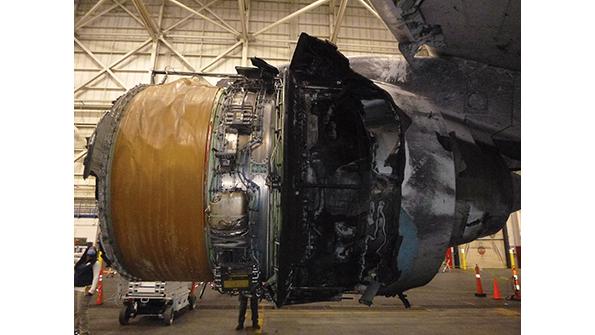
Boeing, arguing that incremental improvements will be safer than waiting for approval of a complete redesign, has asked the FAA to approve a phased approach for upgrading Boeing 737 Next Generation and 777 nacelles.
The requests, filed with the FAA in August and formally acknowledged by the agency last month, lay out timelines for integrating design changes into affected aircraft. The changes were prompted by investigations into fan-blade-out occurrences linked to five engine failures since August 2016. Two involved Southwest Airlines 737-700s powered by CFM56-7B engines, while three others were on 777-200s powered by Pratt & Whitney PW4000 engines—two operated by United Airlines and one by Japan Air Lines.
The proposed 737 changes are more sweeping, as they would affect some 6,300 aircraft in service. Boeing is targeting four sets of upgrades to address issues spotlighted by the NTSB. The changes reinforce the inlet, fan cowl and a fan-cowl door hinge to help ensure that energy from a broken fan blade does not cascade into parts of the nacelle breaking away. The airframer also proposes a new exhaust nozzle.
Boeing is proposing changes to the PW4000 inlet and fan cowl. It also says Pratt will make changes in the engines to address a “core compartment fire” issue reported in the latest occurrence, a February accident that has left the Pratt-powered 777 fleet grounded while the FAA and Boeing revamp fan-blade inspection protocols and agree on the other fixes. Fewer than 130 Pratt-powered 777s are still in the global fleet, with United operating the most, at 52.
The changes address issues that were supposed to be settled during each aircraft’s certification in the mid-1990s. As part of those approvals, Boeing was required to demonstrate, using a combination of tests and analysis, that an entire nacelle could withstand a fan-blade failure. If one component failed, the entire nacelle did not meet the requirements.
Boeing succeeded, but investigations into the recent engine failures spotlighted scenarios that modeling used during the 777-200 and 737-700 certification was not sophisticated enough to predict. New modeling that Boeing is using to develop the design changes can isolate more failure modes. But meeting the relevant FAA rules means demonstrating the entire redesigned system’s airworthiness.
Boeing, in its request, argues that rolling out the changes as they are finalized minimizes risk as quickly as possible.
“Due to the complexity of changes required, not all design changes will be available simultaneously,” Boeing tells the FAA in its 777 petition. “Without an exemption, this system-level showing could only be made after all of the design changes were available, which would delay the associated service bulletin and hardware kit availability dates. This delay would impact operator capability to plan for and achieve a systematic and nominal incorporation of each change in order to meet the anticipated mandated compliance period.”





